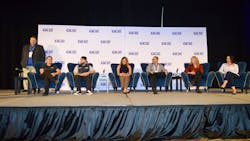The technician shortage problem is nationwide, but one solution, the Collision Engineering Program, addresses it a local or regional level, said Mary Mahoney, vice president of Enterprise Mobility’s replacement and leisure division.
Mahoney, instructors, collision repair shop owners, and recent graduates were part of a discussion panel moderated by I-CAR’s Bud Center at the recent Collision Industry Conference in Las Vegas to talk about details of the program. The program is novel in its approach, which combines labs and classwork with on-the-job training at participating shops in eight-week rotations for two years. After successful completion, students graduate with an associate’s degree. Founded by the Enterprise Mobility Foundation in partnership with Ranken Technical College in St. Louis, Missouri, it concluded its pilot phase about two years ago and has since expanded to a total of seven colleges in California, Illinois, Missouri, Nebraska, and Texas.
“The Collision Engineering Program was developed to build a new generation of highly motivated, passionate, skilled collision repair technologists for the industry,” she said. “It’s education and industry working together in a collaborative partnership. Each of the schools develops their own advisory council to help guide the program through its term. And we think by working closely with industry partners, we can ensure that the training models are what the industry is looking for, and they'll keep up with the trends and the advancements of vehicles that are being made. We kind of like to call this ‘education driven by industry.’”
Laura Lozano, instructor and department chair at Contra Costa College in San Pablo, California, said the classroom offers structured learning and a slower pace. Working in the shop, students “get a little bit of the pressure of completing a task in a certain amount of time.” They then come back to school with a greater understanding of what they’re working toward and knowing what questions they need to ask.
What Makes a Good Shop Partnership
Lozano said an ideal shop partner emphasizes training from I-CAR and the OEMs.
“We do a lot of footwork in meeting with the shops in getting to know their culture, getting to know their technicians who would be mentors of our students. What I think the biggest piece in all of this is finding an employer a manager who is open to going through this process with the student and with the college.”
She and Octavio Cavazos, instructor and department chair at the College of Lake County in Grayslake, Illinois, said it’s necessary to have an open “triangle of communication” between the student, employer, and school.
“If we don't have that open line of communication and that trust and willingness to grow together, we're never going to succeed,” Cavazos said. “The employers have to understand that it is a process that we have to go through. They have to be willing to put forth the effort, just like the student is and just like the schools are.”
Amber Alley, the Society of Collision Repair Specialists chairman and manager of Barsotti's Body and Fender in San Rafael, California, agreed. She is helping train a second apprentice student.
“You want to see these young people succeed. They've taken the first step: they chose your shop. You have all this support, but you really have to step up your game.”
What Helps Attract Young Apprentices to Shops
Sam Ortega, a graduate of Contra Costa College’s program said he was impressed with the “very clean and up-to-date” environment at Accurate Auto Body, in Richmond, California. “And all the employees were really nice and respectful.”
“I wanted to know that the shop was just as eager to progress and learn about what was coming next in the next models as I was,” said Karina Badillo, a graduate of the College of Lake County’s program. She had considered other technical programs, including welding. “But nothing was quite as comforting as this program was. It is really nice to have a team behind you.”
Alley reinforced Badillo’s point about needing to make the shop environment and culture welcoming to women, which is not the reputation it historically has had.
“I think a program like this is exactly what we need to change that perception of the industry. It gives young ladies who do want to enter the industry a very safe way to do that. For 30 years, I've been in a management position of some capacity in the industry, and I've never employed a woman technician. That's a problem, and I want to change that. And I just don't know that we can have the conversation about a labor shortage if we don't also make it an industry that promotes that in a positive fashion. And I think this is a start to that.”
Tiffany Silva, the owner of Accurate Auto Body, is on her third student apprentice.
“The success of this program is something that we need to see nationwide," she said. "And then we will stop complaining about the shortage of techs, and we'll also have strong female role models on our shop floors, not only in our offices. The majority of my workforce is female. I believe I have eight females, and I have 10 people who are under the age of 25 working in our facility.”
What Leads to a Successful Apprenticeship
Shop managers who strive for a successful program will achieve it, although not overnight, said Cavazos, who said he has graduated 26 student apprentices, all of whom are still working in the industry.
“Employers, I'm going to give you the same pitch that I would pitch to the parents or to the students coming into our program: If you give us two years of dedication, learn the process, and work with us, at the end of those two years, you will have an astonishing employee on your floor. I told my students: Give me two years of honest hard work, and you will have a team supporting you through those two years to make you successful."
The extra effort yields a technician ideal for the shop environment to which he or she has grown accustomed, he said.
“If you want a technician right now, if you're looking for an A tech, don't come to me; don't come to Laura. We don't have those. But we have a model that can get you a very strong graduate at the end of two years, that you can then mold into whatever it is that technician should be for your facility.”
For more information, go to https://www.beacollisionengineer.com
About the Author
Jay Sicht
Editor-in-Chief, FenderBender and ABRN
Jay Sicht is editor-in-chief of FenderBender and ABRN. He has worked in the automotive aftermarket for more than 29 years, including in a number of sales and technical support roles in paint/parts distribution and service/repair. He has a bachelor's degree in journalism from the University of Central Missouri with a minor in aviation, and as a writer and editor, he has covered all segments of the automotive aftermarket for more than 20 of those years, including formerly serving as editor-in-chief of Motor Age and Aftermarket Business World. Connect with him on LinkedIn.
Don't miss Jay's next article or podcast. Sign up for FenderBender Today's Collision Repair News and ABRN eNews here.


